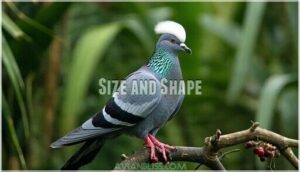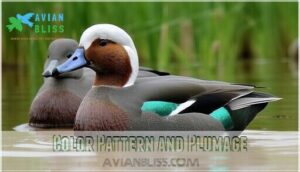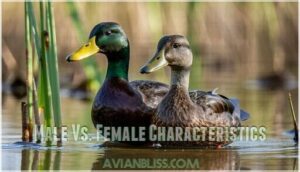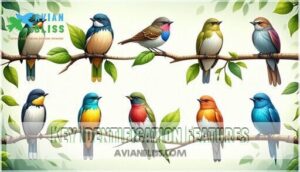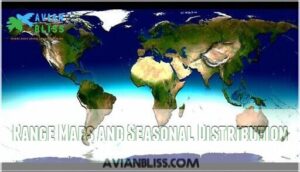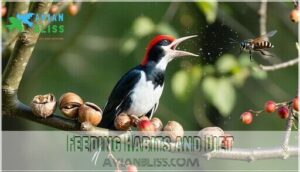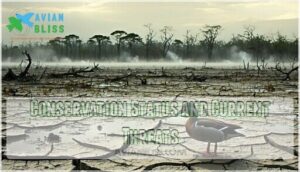This site is supported by our readers. We may earn a commission, at no cost to you, if you purchase through links.
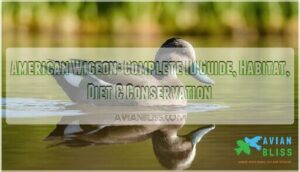
They’re clever feeders who surface-feed on aquatic plants but also steal food from diving ducks in deeper water. Their blue-gray bills and "no-necked" look when floating make them easy to spot.
With stable populations and "Least Concern" status, they remain common throughout their range. Understanding their seasonal feeding patterns reveals surprising insights about waterfowl survival strategies.
Table Of Contents
- Key Takeaways
- American Wigeon Identification Guide
- Habitat Preferences and Distribution
- Feeding Habits and Diet
- Breeding, Nesting, and Life Cycle
- Conservation Status and Current Threats
- Frequently Asked Questions (FAQs)
- What is the difference between a wigeon and an American Wigeon?
- Where do American Wigeons live?
- What is interesting about the American Wigeon?
- What is the common name for American Wigeon?
- What proportion of their diet consists of aquatic plants?
- How do American Wigeons adapt to varying water levels?
- Can American Wigeons be found in urban backyard environments?
- How long do American wigeons typically live?
- What predators threaten American wigeon eggs and ducklings?
- Do American wigeons form lifelong pair bonds?
- Conclusion
Key Takeaways
- You’ll identify American Wigeons by their compact shape, blue-gray bills, and distinctive head patterns – males sport white crown stripes with green ear patches, while females have gray heads with pinkish bodies.
- You can find these adaptable ducks in shallow wetlands across North America, where they’re clever feeders who dabble for aquatic plants but also steal food from diving ducks in deeper water.
- You’ll hear their distinctive "whew-whew-whew" whistle call and see their large white wing patches when they take flight, making them easier to spot among mixed waterfowl flocks.
- You don’t need to worry about their conservation status, since American Wigeon populations remain stable with a "Least Concern" rating, though they face ongoing threats from wetland loss and climate change.
American Wigeon Identification Guide
You’ll recognize American Wigeons by their compact duck shape with short bills and round heads that create a distinctive no-necked look when they sit on water.
Watch for that telltale round head and stubby bill combo – it’s the American Wigeon’s calling card on any wetland
Look for the males’ white crown stripes and green ear patches or the females’ gray heads with pinkish bodies to confirm your identification.
Size and Shape
American Wigeon are compact ducks with distinctive body proportions. You’ll notice their round head and short neck appearance, creating a "no-necked" look when resting.
Length measurements span 16.5-23.2 inches, with weight variation from 19.1-46.9 ounces. Their wingspan reaches 33.1 inches. Sexual dimorphism affects size, with males usually larger than females.
Color Pattern and Plumage
Several key features help you identify American Wigeons in the field. Male Plumage shows bright white crowns and green ear patches during breeding season. Female Plumage appears more subdued with grayish heads and warm brown bodies. Seasonal Variation affects color intensity as birds shift between Breeding Plumage and Nonbreeding Plumage.
- White crown stripe on males earned them the nickname "Baldpate"
- Iridescent green patches shimmer behind male eyes like emeralds
- Pink-buff chest coloring warms the male’s overall appearance
- Gray heads on females contrast beautifully with their bodies
- Blue-gray bills stay consistent across all Color Pattern variations
Male Vs. Female Characteristics
Males stand out with their crisp white crown stripe and emerald green ear patch against gray heads. Females show subtler gray heads with warm pinkish bodies. During breeding season, males display brighter plumage differences while females focus on camouflage for nesting duties.
American Wigeon
Key Identification Features
When you’re looking at an American Wigeon, focus on these key American Wigeon Identification features that set them apart from other ducks:
- Compact build – Short neck and rounded head create a distinctive no-necked appearance
- Blue-gray bill – Small and narrow compared to other dabbling ducks
- Head patterns – Males show white crown stripe with green ear patch; females display gray heads
- Body posture – Sits low on water with head pulled down into shoulders
- Vocalizations – Listen for the male’s whistled "whew-whew-whew" call during identification
In-flight Markings
Watch for those large white wing patches when American Wigeon take flight. Both sexes show these distinctive white patches on their upperwings, plus an iridescent green speculum. Their Flight Silhouette appears compact with steady wingbeats.
Flocking Behavior means you’ll often spot multiple birds together, showing synchronized aerial displays. These flight patterns are important behavioral identification clues.
Habitat Preferences and Distribution
You’ll find American Wigeons in diverse wetland habitats, from shallow prairie potholes to coastal marshes and flooded agricultural fields.
These adaptable ducks migrate across North America using major flyways and can quickly adjust to new environments when their preferred habitats change.
Preferred Wetland and Grassland Habitats
American Wigeon thrive in shallow freshwater marshes with dense aquatic vegetation. You’ll spot them grazing in nearby grasslands and agricultural fields. They need habitat connectivity between wetland and upland areas.
Water quality matters for their food sources. Habitat degradation from development threatens these preferences. Look for them where wetland vegetation meets open grassland grazing areas.
Range Maps and Seasonal Distribution
Since breeding populations stretch from Alaska across Canada’s boreal forests down to northern U.S. states, Range Maps reveal dramatic Distribution Shifts throughout the year. Wintering Areas span from southern United States through Mexico to northern South America.
Spring Migration peaks February through May, while Fall Migration occurs September through October. Breeding Expansion eastward since the 1930s shows increasing Habitat Connectivity.
Migration Triggers vary by location and climate conditions across Wintering Grounds. These maps show the year-round distribution of the American Wigeon.
Migration Patterns and Flyways
Wigeons use four major flyways across North America: Pacific, Central, Mississippi, and Atlantic routes. Fall migration begins in mid-August, with peak movements occurring from September through October. Spring migration starts in February and peaks from March through May. Wind direction, cold fronts, and seasonal timing are key factors that guide birds along these flyways.
These navigation strategies are crucial for wigeons to locate stopover habitats during their long journeys. The Atlantic Flyway is particularly notable, stretching from Florida to Greenland and providing essential habitat for migrating wigeons.
Flyway conservation efforts play a vital role in protecting critical migration corridors for American Wigeon populations.
Adaptation to Changing Environments
Resilience runs deep in American wigeons. These adaptable ducks shift their migration patterns northward as temperatures warm, adjusting their habitat preferences and breeding ranges in response to climate threats.
Their dietary shifts help them find new food sources when traditional wetland plants disappear. This evolutionary flexibility keeps their conservation status stable despite mounting climate pressures.
Feeding Habits and Diet
You’ll observe American Wigeon feeding habits change based on water depth and available food sources.
These dabbling ducks eat mostly plant material like pondweed and widgeon grass but they’ll also steal food from diving ducks in deeper water.
Dabbling Duck Behavior
You’ll observe dabbling ducks like American Wigeon using their signature head-down feeding technique. These birds exhibit fascinating social interactions and foraging strategies that set them apart from other waterfowl.
- Surface feeding – They tip forward to reach underwater vegetation while keeping their tails up
- Food stealing behavior – Wigeons often rob diving ducks and coots of their hard-earned meals
- Diurnal activity patterns – Most feeding occurs during daylight hours with distinct wigeon vocalizations
Primary Food Sources
American Wigeon diet centers on aquatic vegetation and submersed aquatic vegetation. You’ll find them targeting aquatic plant stems and showing distinct seed preferences.
Their foraging versatility includes insect consumption, especially for ducklings. These adaptable birds practice nocturnal feeding when pressured.
Diet varies seasonally, with pondweed, naiad, and widgeon grass being primary choices throughout their range.
Plant Material Consumption
You’ll find these ducks munch on aquatic vegetation like pondweed and naiad with impressive skill. Their plant-based diet centers on leafy stems and seeds from aquatic plant material.
American Wigeon show impressive foraging versatility when selecting nutritional plant variety. Their seed consumption habits focus mainly on widgeon grass and milfoil. This specialized diet keeps them healthy year-round.
Feeding With Other Waterfowl
When you watch American Wigeon in mixed flocks, you’ll notice their clever food robbery tactics. These dabbling ducks aggressively steal aquatic plant material from diving species like coots.
Diet overlap creates foraging competition among surface feeding ducks. Some waterfowl have specialized bills that help them feed efficiently.
During hunting pressure, nocturnal feeding becomes common. This aggressive feeding behavior helps them access food sources they couldn’t reach alone.
Breeding, Nesting, and Life Cycle
You’ll find American Wigeon breeding patterns start when pairs form on wintering grounds before spring migration begins.
These ducks nest later than most dabbling ducks and build shallow grass-lined nests where females incubate 8-11 eggs for about 24 days.
Breeding Habits and Pair Formation
During winter months, American Wigeon pair formation begins before spring migration kicks off. Older males compete fiercely for mates, showing off white wing patches in dramatic courtship displays.
Their breeding habits depend on habitat quality and food availability. These late nesters start their breeding plumage transformation early, with successful pairing timeline extending through incubation for better nesting success.
Nest Site Selection and Construction
During breeding season, you’ll spot female wigeons selecting nest sites in dense grassland cover near water edges. She builds her nest using available materials like dried grasses and sedges. The shallow depression measures about 8 inches across, with thick concealment from surrounding vegetation.
Consider specialized duck nesting to improve their nesting environment. Site fidelity varies, but females often return to successful nesting areas from previous years.
Egg Laying and Incubation
Laying begins once the female completes her nest site preparation. You’ll observe clutch sizes averaging 8-11 creamy white eggs laid over consecutive days.
The incubation period spans 23-24 days, with the female handling all duties alone. During this breeding season phase, nesting success depends on her dedication to parental care.
The hatching process occurs synchronously, launching the next life cycle stage.
Duckling Development and Brood Care
After eggs hatch, you’ll observe American Wigeon ducklings following their mother to water within hours. Young feed themselves on insects and small invertebrates during early growth stages.
The female provides protection through predator avoidance techniques while ducklings develop waterproof feathers. Post-fledging occurs around seven weeks when young achieve flight capability in their breeding habitat.
Conservation Status and Current Threats
You’ll find American Wigeon populations remain stable with a "Least Concern" conservation status, though they face several key threats.
Wetland loss and habitat degradation pose the biggest challenges, while disease outbreaks and climate change add pressure to breeding populations.
IUCN and Population Trends
American Wigeon’s IUCN status shows encouraging Population Stability with a "Least Concern" rating. Current populations are around 2.99 million birds, though long-term Population Trends indicate a slight decline.
Conservation efforts focus on:
- Range Expansion eastward since the 1930s
- Population monitoring through USFWS surveys
- Threat Mitigation via habitat restoration programs
The Future Outlook remains positive despite Hunting Impact concerns.
Climate Change and Habitat Loss
Wetland destruction hits American Wigeon hard. Climate models show you’ll lose two-thirds of Prairie Pothole breeding grounds by 2080. Shifting migration patterns emerge as rising temperatures push birds north.
Habitat degradation reduces food availability across their range. Only 35% of current breeding habitat stays stable. Reduced biodiversity weakens ecosystem services.
Conservation strategies must target wetland restoration to prevent declining breeding success.
Hunting and Disease Risks
Hunting Seasons bring challenges beyond habitat loss. American wigeon face threats that impact population numbers in three key areas:
- Lead Poisoning – Despite hunting regulations requiring nontoxic shot since 1991, spent lead ammunition remains in wetlands causing disease transmission.
- Disease Risks – West Nile virus and avian pathogens spread rapidly through waterfowl populations during migration.
- Harvest Impact – Annual harvest information shows over 571,000 American wigeon taken per season, requiring careful habitat management to maintain stable numbers.
Conservation Efforts and Management
Conservation groups work hard to protect American wigeon populations through habitat restoration and wetland protection programs. Population monitoring tracks harvest numbers during hunting seasons. Hunting regulations control annual take to guarantee sustainable populations.
Threat mitigation tackles wetland loss and pollution. Resources are available for wigeon habitat improvement. These efforts help maintain stable numbers across North America.
Frequently Asked Questions (FAQs)
What is the difference between a wigeon and an American Wigeon?
Like a birding riddle, you’ll find wigeon refers to three different species worldwide.
All three wigeons are similarly shaped, with a steep forehead and bulbous rear to the head. The American, Eurasian, and Chiloe wigeons are distinct species sharing common traits.
Where do American Wigeons live?
You’ll find American Wigeons across diverse habitats throughout North America. They inhabit freshwater wetlands, lakes, ponds, rivers, coastal areas, grasslands, and agricultural fields from Alaska to California and eastern Canada.
What is interesting about the American Wigeon?
You’ll find American Wigeons fascinating for their thieving ways. They’re nicknamed "poachers" because they steal food from diving ducks and coots.
They also whistle distinctively and were once called "Baldpate" for their white crowns.
What is the common name for American Wigeon?
You’ll hear this duck called by its old nickname that stuck like glue through generations. The American Wigeon was historically known as "Baldpate" because of the male’s distinctive white crown stripe that resembles a bald head.
What proportion of their diet consists of aquatic plants?
You’ll find aquatic plants make up over 90% of their diet. Studies show stems and leaves of aquatic plants "comprised over 92% aggregate dry mass of the diet" with notable consistency year-round.
How do American Wigeons adapt to varying water levels?
You’ll see these birds switch their feeding strategy when water levels change. In shallow water, they dabble and surface-feed like typical dabblers.
When water gets deeper, they cleverly steal food from diving ducks that bring vegetation up.
Can American Wigeons be found in urban backyard environments?
Backyard duck enthusiasts might think they’re running the Four Seasons for waterfowl, but you’ll rarely find these birds in typical residential yards.
They prefer park ponds and urban reservoirs with adequate space.
How long do American wigeons typically live?
Lifespans average just 7 to 3 years in the wild. Males usually live slightly longer than females at around 3 years versus 7 years. The record holder reached 21 years though.
What predators threaten American wigeon eggs and ducklings?
Like sitting ducks, these feathered treasures face serious danger. Raccoons, skunks, foxes, coyotes, snakes, hawks, owls, and crows threaten eggs and young birds.
You’ll find nest predation causes most failures in ground-nesting species.
Do American wigeons form lifelong pair bonds?
No, you won’t find lifelong pair bonds in these ducks. They form seasonal partnerships that begin on wintering grounds.
Most older birds pair up before spring migration starts, but they don’t stay together year after year.
Conclusion
Knowledge is power, and understanding the American Wigeon gives you that power in the field. You now have the tools to identify these distinctive dabblers by their white crown stripes and blue-gray bills.
You understand their feeding habits and habitat needs. You know their conservation status remains stable.
This knowledge helps you appreciate these clever waterfowl during your next wetland visit. The American Wigeon rewards careful observers with its unique behaviors and calls.

